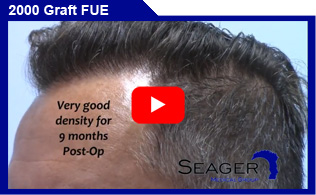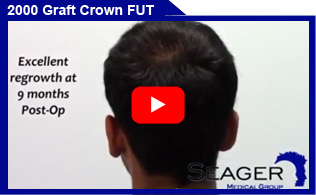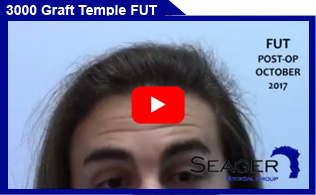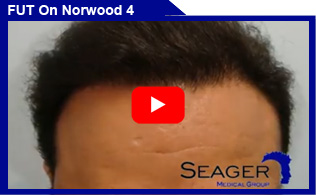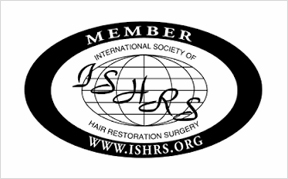Graft Placement
 |
|
Transplanted Hairline created at the Seager Hair Transplant Centre |
By the time, the donor area has been closed, there are enough grafts already prepared to begin placing the grafts according to Dr. Simmons and Dr. McKenzie’s detailed plan. While those grafts are being placed, more grafts are being prepared. Thus grafts will be prepared and placed simultaneously.
For the vast majority of our patients the “stick-and-place method” is used. A fine needle is used to create a tiny hole (which is actually a miniature tunnel) in Dr. Simmons and Dr. McKenzie’s specified angle and direction. A follicular unit graft is then held gently by the protective tissue surrounding the follicular structures and immediately tucked into the newly created opening.
The stick-and-place offers many advantages compared to the method employed at most facilities. Many facilities make all the recipient sites first then place the grafts. Since skin is elastic, the holes start shrinking almost immediately after they are made. Smaller holes are required for the stick-and-place method since they can be filled before they shrink. Smaller holes in turn cause less damage to the skin or the blood supply and the holes can be made closer together than larger holes. Using the stick-and-place method also eliminates the risk of leaving holes unfilled or accidentally “piggy-backing” two grafts into the same opening. Finally, using the stick-and-place method gives Dr. Simmons and Dr. McKenzie flexibility to modify the plan as needed as the procedure continues whereas if the holes are all made in advance, the plan cannot be adapted according to scalp or hair characteristics afterward.
With the older, more conventional mini-graft technique, space must be left between the grafts to ensure proper blood flow, providing the essential supply of blood for grafts to grow. If the grafts are larger, more space has to be left in between. The number of grafts one can transplant at each session is therefore limited. A fewer number of grafts will, therefore, be transplanted at every session. Also, with mini-grafts, a second and often a third and fourth session are usually necessary to fill these spaces left for the blood flow in between these grafts. These extra sessions are also necessary to minimize the tufted “toothbrush” or “cornrow” appearance- and also, to add density.
However, with Dr. Simmons and Dr. McKenzie’s “All Follicular Unit Mega session”, the grafts are so small and placed into such minute pinprick sized holes, that they disturb the blood circulation much less. These smaller grafts can be “dense-packed”, extremely close together. As these grafts are packed so densely, the density of the hair that grows back is usually enough to satisfy most patients after just one session.
BACKThe Seager Advantage!
 Find out how countless satisfied clients lives are being transformed by the Seager Advantage
Find out how countless satisfied clients lives are being transformed by the Seager AdvantageHair Transplants
Ask Any Questions Below
When it comes to hair restoration there are no "bad questions", we invite you to send us your questions and have them answered directly by our highly experienced Seager medical doctor, simply fill in the form below for a hair transplant consultation.No pressure, No Obligation. Steps to hair restoration

